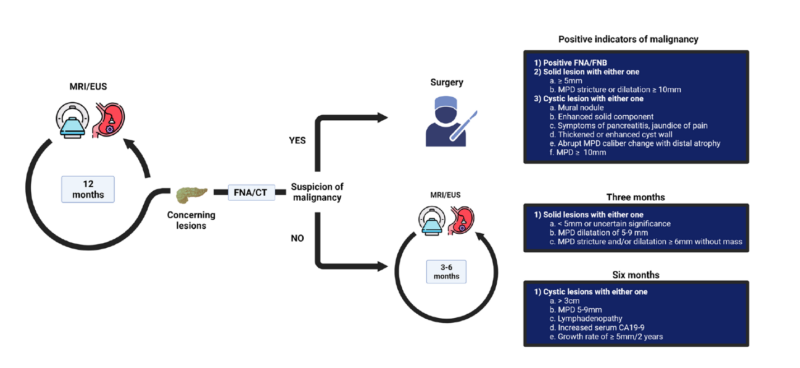
New Paper Alert! Outcomes of high-risk individuals undergoing pancreatic cancer surveillance
Effective Surveillance Strategies for High-Risk Pancreatic Cancer Individuals
Authors: Aleksander M. Bogdanski, Jeanin E. van Hooft, Bas Boekestijn, Bert A. Bonsing, Martin N. J. M. Wasser, Derk C. F. Klatte and Monique E. van Leerdam
Published in Familial Cancer, on April 15, 2024
Introduction:
Pancreatic ductal adenocarcinoma (PDAC) is a leading cause of cancer-related deaths, with a poor prognosis. While population-based screening is not recommended, surveillance is advised for individuals at high risk (HRIs) due to their increased incidence of the disease. This review aims to address the identification of individuals at high risk, discuss the objectives and targets of surveillance, outline how surveillance programs are organized, summarize the outcomes of HRIs undergoing pancreatic cancer surveillance, and provide a future perspective.
Design and Methods:
The review examines the selection criteria for HRIs, including those with a germline pathogenic variant in genes like CDKN2A, STK11/LKB1, and PRSS1/SPINK1, which confer a lifetime PDAC risk ranging from 7.2% to 53.3%. It also considers individuals with a strong family history, such as those with two or more affected first-degree relatives, who exhibit a standardized incidence ratio for PDAC of up to 32.0. The review outlines the primary objectives of surveillance, which are the early detection of PDAC, specifically stage I disease, and high-risk precursor lesions, such as pancreatic intraepithelial neoplasia (PanIN) grade 3 and high-grade intraductal papillary mucinous neoplasm (IPMN). The effectiveness of surveillance was measured by the number needed to screen (NNS) to detect one successful target lesion, taking into account different genetic predispositions and surveillance intervals. The article discusses surveillance methods, including magnetic resonance imaging (MRI), endoscopic ultrasound (EUS), and the limited role of biomarkers like carbohydrate antigen 19-9 (CA19-9).
What We Learned:
Meta-analyses have shown a diagnostic yield for successful target lesions (stage I PDAC, high-grade PanIN, and high-grade IPMN) ranging from 3% in familial pancreatic cancer (FPC) to 12.2% in Peutz-Jeghers syndrome (PJS) carriers. The incidence rate for successful target lesions was reported as 7.4 per 1000 person-years, and the number needed to screen to find one successful target lesion was estimated at 135. This NNS varied considerably, from 51 for individuals with a pathogenic variant in the CDKN2A gene to 250 for those with a BRCA gene mutation.
Key Highlights:
- Individuals with a germline pathogenic variant in genes like CDKN2A (19% lifetime risk), STK11/LKB1 (11-36% risk), and PRSS1/SPINK1 (7.2-53.3% risk) have a higher risk of PDAC and are recommended for surveillance starting at specific ages, often 10 years earlier than the youngest affected relative.
- Surveillance programs typically involve annual MRI and/or EUS, with further assessment using EUS-guided biopsy or CT if concerning lesions are detected. MRI may be preferred for evaluating cystic lesions, while EUS is more adept at assessing solid lesions and parenchymal changes.
- Recent studies have reported varying outcomes, with some finding no PDAC cases in the FPC group and others detecting PDAC cases in FPC individuals, potentially due to unidentified germline pathogenic variants.
- Interval cancers, where PDAC is diagnosed between surveillance examinations, remain a challenge, with nearly half of detected cases occurring within 11 months of the previous negative examination.

Key Takeaway Messages:
While pancreatic cancer surveillance in HRIs has shown promising results, there is still room for improvement in early detection strategies. Novel biomarkers, advanced imaging techniques, and a better understanding of the underlying mechanisms driving rapid PDAC progression are needed to enhance the efficacy of surveillance programs. Additionally, establishing guidelines for discontinuing surveillance, considering individual factors, is essential to maintain the effectiveness and minimize the burden on HRIs.
Summary by Amalya Sargsyan, MD
Aspects and outcomes of surveillance for individuals at high-risk of pancreatic cancer
About OncoDaily
OncoDaily was founded in 2023. It is a US-based oncology media platform, which features the latest news, insights, and patient stories from the world of oncology. Within a short period of time it became one of the leading oncology media platforms globally.
OncoDaily gathers content from various sources, including social media posts from renowned oncologists from all over the world, news from oncology societies and cancer centers, patient and survivor stories, and career-related information for professionals.
The mission of OncoDaily is to empower patients, survivors, and professionals with the knowledge and inspiration they need to fight cancer. The motto of OncoDaily is “Cancer doesn’t take a day off – neither do we”.
